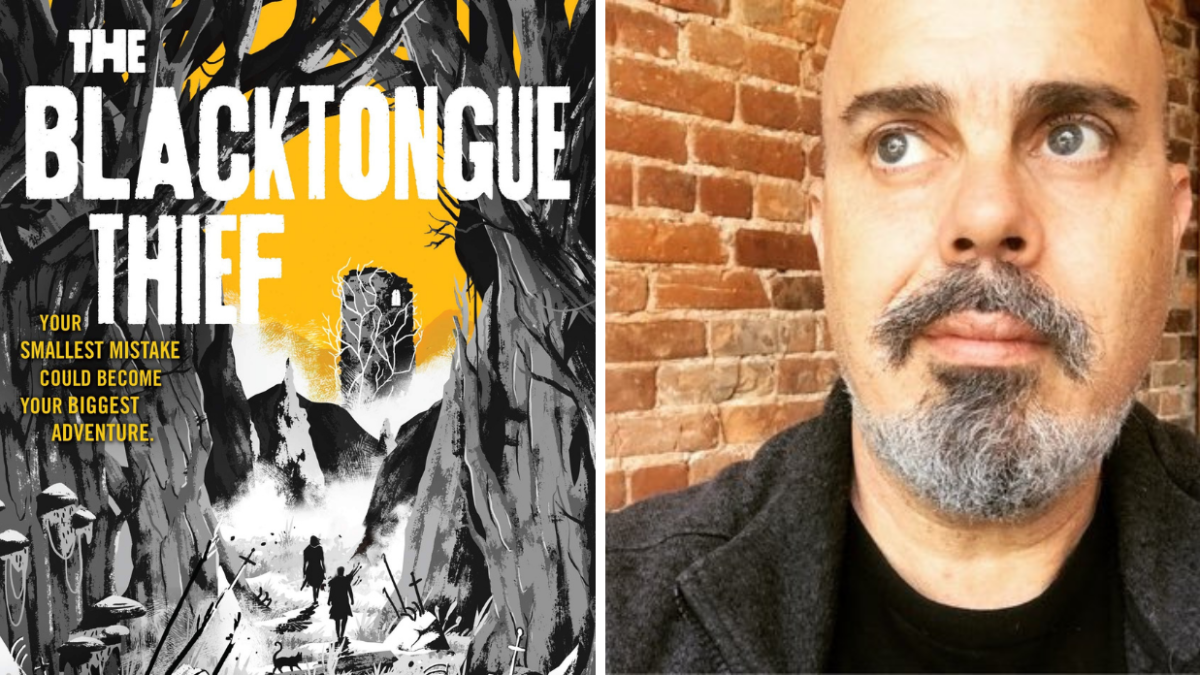Insults, World-Building, and Blind Cats: An Interview with The Blacktongue Thief’s Christopher Buehlman
We talked to author Christopher Buehlman about his transition from horror to high fantasy in the much-anticipated The Blacktongue Thief.

This post is sponsored by 
It only takes a small, insignificant moment to completely change the course of a life. It’s that premise from which The Blacktongue Thief starts. Kinch Na Shannack, working thief, is spared when a banditry gig goes south. The Spanth warrior who spares him, Galva, is on a quest—and the Taker’s Guild, for which Kinch works, assigns him to accompany her, gain her trust, and wait for further instruction. As he travels with Galva, and, soon after, a witch companion Norrigal, he begins to question just where his allegiance lies, and what he owes his newfound friends—and the world.
From the first pages of The Blacktongue Thief, this Den of Geek reviewer was hooked, in no small part because the narrative voice is quite simply a delight. Kinch welcomes readers straight into a world where humanity was nearly destroyed by goblins, and where giants are encroaching on the northern border. But besides all that, a person’s got to make a living, and Kinch has a debt to the Takers Guild he’s bound to pay off. Kinch tells the story like he’s sitting next to you at a table in the pub, sharing the worst and best moments with a lingering delight at the sheer telling of the tale. He exaggerates and lies, but lets you know he’s doing so with a wink and a nudge.
This fantasy novel invites readers to share a pint of whatever’s good, learn some colorful language from a variety of nations, and maybe even join in a song or two. If the atmosphere I just described feels a bit like a renaissance festival, it should come as no surprise. Author Christopher Buehlman, previously best known for his poetry and his horror novels (and shortly to become known as a rising star in fantasy, as well), is also Christophe the Insultor, Verbal Mercenary, a regular comedic performer at renaissance festivals.
“My career as a professional insultor on the renaissance festival circuit definitely informed Kinch’s language,” Buehlman explains. “He’s always ready to trade barbs, and he isn’t afraid to work blue.” Blue language is absolutely a highlight of the book; Kinch’s swearing is utterly inventive, and because he speaks a number of languages, the different curses reveal a lot about the cultures that created them. Kinch presents the Spanths, particularly Galva, as overly honorable and a bit uptight, something that’s not only revealed in her lack of patience for Kinch conversing with a cat he rescues, but also in the way she argues the proper conjugation of a particularly colorful swear. (You can read some dictionary-style definitions of Kinch’s curse words over at the Tor/Forge blog.)
There are linguistic connections between the curse words (and other vocabulary) in the novel and the real-world counterparts that provided inspiration. “The Galts are not unlike the Celts; I thought of them not as a direct analog to the Welsh or the Scots or the Irish, but as a lost tribe,” Buehlman shares. “There is something of the gaelic in Kinch’s poetic, artistically gifted, externally governed homeland, and his language, storytelling, and, yes, insults and doggerel, come from that. As for chodadu, it is based on Spanish jodido, and operates similarly. Jilnaedu, on the other hand, is a more original Spanth term, meaning ‘vicious idiot.’ As with Galtia and Ireland, Ispanthia is not Spain, but it and its language would snuggle in nicely between Spain, Portugal, and Catalonia. I think Spaniards will recognize Galva but also find lots of new things to discover about her and her country.”
One of the most fascinating aspects of Kinch’s world is the impact the Goblin Wars have had on the human population. The goblins came and fought in three waves; the first two were fought by men, but soon there weren’t enough men left to fight. “Women had to go under arms,” Buehlman describes. “More, they had to win. And they did. For now. The Daughters’ War wasn’t about fame or glory, or even power and wealth—it was a raw, muddy, no-holds-barred struggle for survival between two competing species, one of whom regards the other as a food source.” The win came, but at a great cost. Humans have taken a huge hit, and the majority of humans are now women, putting women in positions of power throughout all of the human territories.
In fact, the book is populated with women who hold their own against Kinch’s narrative voice. While we get Kinch’s introspection and his assessment of his own character, we see him against a company of strong female characters. Galva is a warrior, honorable, devoted, the kind of knight Don Quixote dreamed of being. Norrigal isn’t an accomplished witch yet—this is her first assignment outside her apprenticeship—but her raw power is astonishing, and her willingness to do the dirty work as needed gives her a wonderfully practical edge. Sesta, one of Kinch’s contacts with the Taker’s Guild, is a ruthless Assassin-Adept, skilled at both magic and murder, so confident that she treats Kinch more like a pest than a tool, even when insisting he follow the terms of his assignment. While there’s a bit of romance, none of the women feel put into the narrative just for the sake of being Kinch’s love interest—in fact, they all feel as though they’d do just fine without him, if it came down to it, and he’s lucky they’ve let him stick around to tell the story.
The desire to depict so many women in control of the world and the narrative came from one of Buehlman’s world-building ideas: “I wanted to present a world that would show the reader how artificial the idea of patriarchy is,” he says, “and how it could be turned on its head with a big enough catalyst.”
Buehlman’s world is both beautiful and terrible—the consequences of the Goblin Wars are present in every aspect of the book, including in the appearance of actual goblins. That looming sense of dread, that humans might not win the next time if it came down to it, lend an intensity to the world, and may remind readers that Buehlman’s previous novels fell into the horror category. “Writing horror is a bit like writing form poetry,” he describes. “With a sonnet, a villanelle, or a pantoum, you have to respect a rhyme scheme, or a repetition pattern, and/or a syllable count. With horror, you have to establish a certain tone, and you have to check in with the reader’s amygdala every so often. This isn’t exact or formulaic, as it can be in poetry, but it needs to have its own internal rhythm. You can have a long build up, but you must bake in a sense of dread–the reader will feel betrayed, and rightly so, if your premise advertises one kind of story, and they get something else entirely for 70% of the read. Horror, like comedy, is binary. It succeeds or fails viscerally.”
Making the switch to fantasy meant making some changes. “Fantasy… is much more forgiving. The reader primarily expects a sense of wonder, a sense of going someplace new. It’s more like free verse. You can do anything you like, as long as you tell a good story and fascinate,” Buehlman shares. He also identifies a few common traits between the genres: “If I took anything with me from horror to fantasy–aside from, hopefully, the universally necessary elements of character, pacing, and clear language–it was that sense of dread. We see the goblin ship coming, and there’s no way off the island. We feel the footsteps of the approaching giants, and hear their horns, but this is a strange city and we don’t know where to run. Too late—the humans on chains that they use to flush us out of our warrens have already seen us.”
The horror elements are well balanced by companionship (particularly in the form of one furry feline) and song. “Kinch has an inexhaustible supply of songs to sing or quote, and singing is of course quite popular in a world without electronic media,” Buehlman muses. “Songs are how people once got their entertainment, expressed emotions, even got their news.” The prominence of music also harkens back to Buehlman’s renaissance festival roots: “Renaissance festivals put a high standard on songs, both as stage entertainment and as something patrons can participate in. And so does Kinch’s world.”
As for that furry feline: Bully Boy appears early on in the narrative and becomes increasingly important as the story goes on. (Buehlman frequently seeds world-information so nonchalantly that when they become relevant as plot elements, this reviewer was impressed at how cleverly the book was structured to hide the significance of those details until they mattered.) When Kinch first meets Bully Boy, a blind cat, the poor creature is about to be captured by some local ruffians, who will, we’re led to believe, put the cat to death. Kinch takes pity and saves the cat—getting arrested in the process—and the two soon become fast friends. But despite what readers might assume, Buehlman was not always a cat lover. The acknowledgements at the end of the book reveal that Bully Boy was inspired by a real cat.
“Bully Boy never would have been had not a blind tabby showed up on my doorstep in 2015, as I was finishing up The Suicide Motor Club,” says Buehlman. “The antagonist of that book is a sumbitch vampire named Luther, and this poor, blind, sick street cat had the biggest fangs I’d seen on a feline outside of a smilodon exhibit. So Luther he became. But you couldn’t find two more different critters than vampire Luther and cat Luther. The latter was one of the most loving, most trusting beings I ever had the pleasure to know. I was decidedly not a cat person before he came raoing at my door—I was a dog man from way back. But when a creature delivers its life into your hands and starts to follow you everywhere you go, clearly loving you and wanting nothing as much as to live purring in your lap or on your chest, it wears you down. If you’ve got feelings, I mean. And I had some. I now recognize canines and felines as equally deserving of our love and companionship, even if we don’t always deserve theirs.”
While The Blacktongue Thief completes a story, the ending leaves several loose threads that readers will be glad to know Buehlman is working on tying up in the sequel. “I’m still in planning and world-building, which is a massive part of writing a fantasy novel with sufficient layers to feel credible,” he reveals. “Let’s just say we’ve got mountains to cross, more and different giants to meet, and one very nasty book to drag secrets out of. Also, look for a more comprehensive telling of Galva’s experiences as a young soldier in the Daughters’ War.”
In the meantime, Buehlman is also digging into the rules for the card game Kinch plays (sometimes with good luck and sometimes bad): Towers. “I wanted a game that would showcase Kinch’s luck-gift, and to occupy the same place in this world as poker does in ours,” Buehlman says of its development. “There are definitely elements of poker in Towers; but you’ll also find traces of Stratego, that simple kids’ card game War, chess, and Magic. I and others have found it to be addictive, but also delightfully complex. There are lots of ways to win, and lose, and strategy is a huge component–nearly as important as luck. And yes, I believe lots of blood would be drawn over this game if it were played for money in rougher parts of town.”
Whether sitting over a game or sitting around a table, sharing a drink and a song and exchanging insults, Kinch and Buehlman both use storytelling flare to keep readers deeply engaged in the story and the world. And the swearing, songs, and story will stick with readers long after they turn the last page.
The Blacktongue Thief hits bookshelves on May 25th, 2021. Find out more here.
